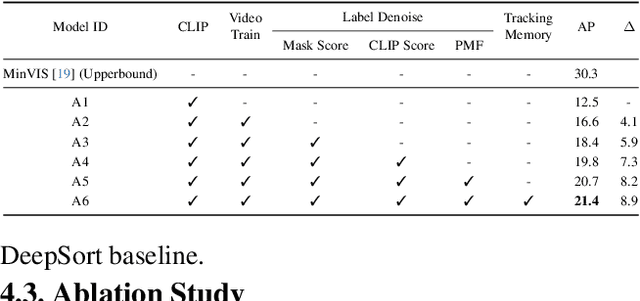Ser-nam Lim
UVIS: Unsupervised Video Instance Segmentation
Jun 11, 2024



Abstract:Video instance segmentation requires classifying, segmenting, and tracking every object across video frames. Unlike existing approaches that rely on masks, boxes, or category labels, we propose UVIS, a novel Unsupervised Video Instance Segmentation (UVIS) framework that can perform video instance segmentation without any video annotations or dense label-based pretraining. Our key insight comes from leveraging the dense shape prior from the self-supervised vision foundation model DINO and the openset recognition ability from the image-caption supervised vision-language model CLIP. Our UVIS framework consists of three essential steps: frame-level pseudo-label generation, transformer-based VIS model training, and query-based tracking. To improve the quality of VIS predictions in the unsupervised setup, we introduce a dual-memory design. This design includes a semantic memory bank for generating accurate pseudo-labels and a tracking memory bank for maintaining temporal consistency in object tracks. We evaluate our approach on three standard VIS benchmarks, namely YoutubeVIS-2019, YoutubeVIS-2021, and Occluded VIS. Our UVIS achieves 21.1 AP on YoutubeVIS-2019 without any video annotations or dense pretraining, demonstrating the potential of our unsupervised VIS framework.
Distilling Vision-Language Pretraining for Efficient Cross-Modal Retrieval
May 23, 2024Abstract:``Learning to hash'' is a practical solution for efficient retrieval, offering fast search speed and low storage cost. It is widely applied in various applications, such as image-text cross-modal search. In this paper, we explore the potential of enhancing the performance of learning to hash with the proliferation of powerful large pre-trained models, such as Vision-Language Pre-training (VLP) models. We introduce a novel method named Distillation for Cross-Modal Quantization (DCMQ), which leverages the rich semantic knowledge of VLP models to improve hash representation learning. Specifically, we use the VLP as a `teacher' to distill knowledge into a `student' hashing model equipped with codebooks. This process involves the replacement of supervised labels, which are composed of multi-hot vectors and lack semantics, with the rich semantics of VLP. In the end, we apply a transformation termed Normalization with Paired Consistency (NPC) to achieve a discriminative target for distillation. Further, we introduce a new quantization method, Product Quantization with Gumbel (PQG) that promotes balanced codebook learning, thereby improving the retrieval performance. Extensive benchmark testing demonstrates that DCMQ consistently outperforms existing supervised cross-modal hashing approaches, showcasing its significant potential.
Towards Cross-modal Backward-compatible Representation Learning for Vision-Language Models
May 23, 2024Abstract:Modern retrieval systems often struggle with upgrading to new and more powerful models due to the incompatibility of embeddings between the old and new models. This necessitates a costly process known as backfilling, which involves re-computing the embeddings for a large number of data samples. In vision, Backward-compatible Training (BT) has been proposed to ensure that the new model aligns with the old model's embeddings. This paper extends the concept of vision-only BT to the field of cross-modal retrieval, marking the first attempt to address Cross-modal BT (XBT). Our goal is to achieve backward-compatibility between Vision-Language Pretraining (VLP) models, such as CLIP, for the cross-modal retrieval task. To address XBT challenges, we propose an efficient solution: a projection module that maps the new model's embeddings to those of the old model. This module, pretrained solely with text data, significantly reduces the number of image-text pairs required for XBT learning, and, once it is pretrained, it avoids using the old model during training. Furthermore, we utilize parameter-efficient training strategies that improve efficiency and preserve the off-the-shelf new model's knowledge by avoiding any modifications. Experimental results on cross-modal retrieval datasets demonstrate the effectiveness of XBT and its potential to enable backfill-free upgrades when a new VLP model emerges.
 Add to Chrome
Add to Chrome Add to Firefox
Add to Firefox Add to Edge
Add to Edge